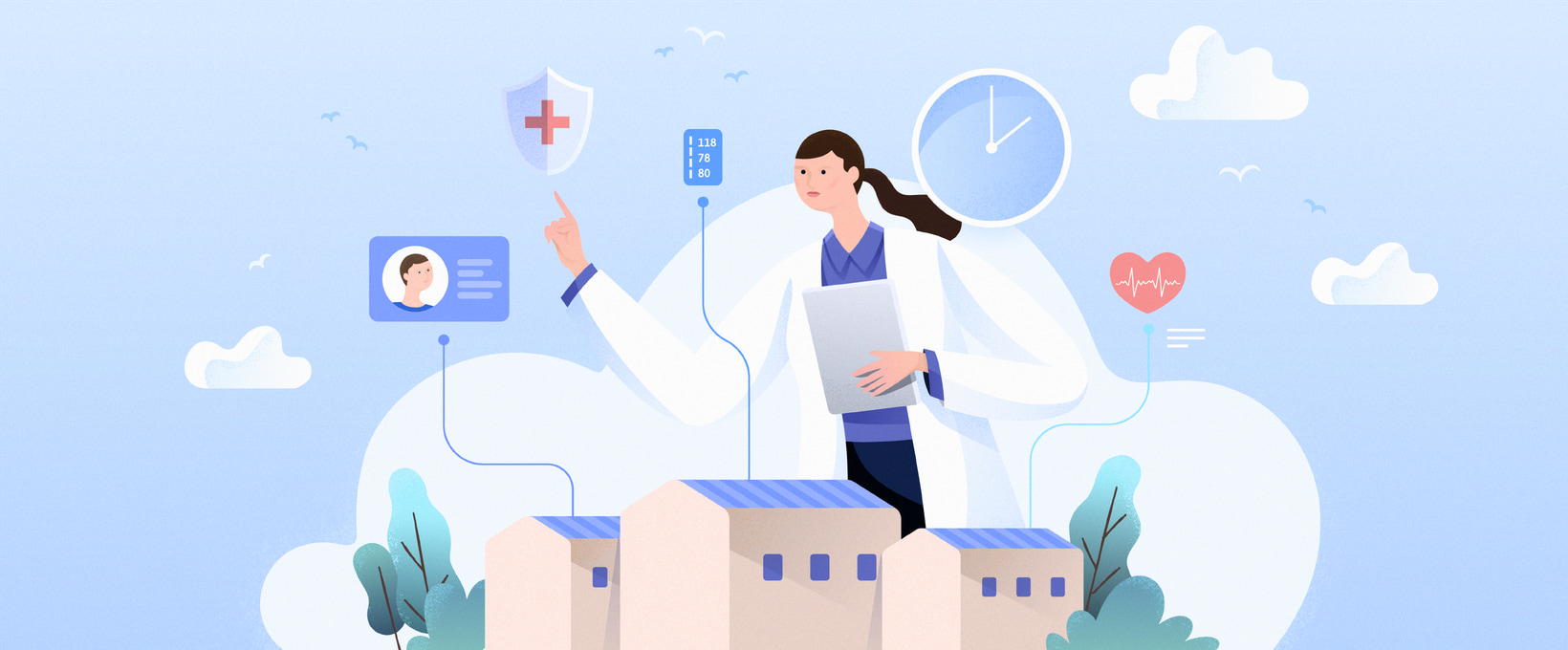- What actually drives the telemedicine market?
- Structure of the Global Telemedicine Market
- Telemedicine. Overview of future trends
- Role of software in the market
- Issues with the current IT solutions
- We as a tech partner for telemedicine development projects
- Wrapping up our overview
To start this overview of telehealth trends, our telemedicine software development company will focus on some fundamentals. The basic underlying fact here is that telemedicine, at least partly, removes the need for time-consuming and costly in-person visits paid to healthcare facilities. Instead, certain clinical services are provided remotely, via devices connected to the internet. These, when it comes to the telemedicine market, include:
- Media for communication with medical professionals;
- Remote patient monitoring technology that tracks, processes, analyzes, and transmits health data.
- Both facets build upon compliant and protected data handling practices (e.g. use of blockchain in healthcare).
This market has been experiencing unprecedented growth recently. Before COVID-19 arrived, back in 2019, it was valued at slightly less than $50 billion. By the end of this decade, around 2030, it is projected to hit almost $460 billion.
In this particular case, correlation means causation. The pandemic did give an enormous boost to “distanced” corporate and social practices, from education to business meetings. Under the conditions of an unprecedented health crisis, telemedicine could not be an exception. However, there are several other factors in place that make this market growth progressive and sustainable. Let’s overview them.
What actually drives the telemedicine market?
In addition to the impetus brought about by COVID and the unfortunate ever-present threat of potential future pandemics, the telemedicine market growth is fueled by:
-
Population aging. By 2030, one out of every six individuals worldwide will be aged 60+, meaning that the proportion of those aged 60+ is anticipated to rise from 1 billion in 2020 to 1.4 billion by then.
Looking ahead to 2050, the global population of individuals aged 60+ is projected to almost double to 2.1 billion. Additionally, the number of individuals aged 80 years or older is forecasted to triple between 2020 and 2050, reaching a total of 426 million.
Longer life spans do not guarantee good health all life long. The process of aging is inevitably linked with various chronic conditions, which necessitates care;
-
As pressures on healthcare systems grow, costs are also on the rise. For instance, a recent global study shows that, back in 2023, there was a notable surge in global medical expenses, rising by 10.7%, marking a record high compared to the 7.4% increase witnessed in 2022. Insurers anticipate an average cost rise of 9.9% for 2024;
-
Concurrently, more people than ever have access to the WWW. More than 5.3 billion individuals worldwide are connected to the Internet, indicating that over 65% of the global population enjoys access to online resources.
As a result, we can observe two simultaneous shifts:
- More accessible and economical practices are needed;
- More and more patients are open to interactions via the web.
Together, they are boosting the telemedicine market share.
Structure of the Global Telemedicine Market
In a nutshell, market research experts could divide the global telemedicine market into three chief sub-categories:
- Teleconsulting market, i.e. e-visits to doctors, which can be described as online-held consultations with some examination potential;
- Telemonitoring market, i.e. tracking of a patient’s condition remotely;
- Teletraining market, i.e. remote access to educational content, training programs, coaching platforms, etc.
Let’s zoom in on all dimensions to recognize the most important current trends:
-
Brief overview of the market of online consultations. Globally, the revenue generated in the domain of online doctor consultations is expanding, from $20 billion in 2021 to almost $24 billion in 2023. Another promising figure is the anticipated 2028 record high of around $36 billion. Also, the average spend per user has also been growing steadily since 2022.
There are far-reaching transformations behind these figures. For instance, in the US alone, the adoption rate of virtual consultations among doctors surged from 14% in 2016 to a striking 80% by 2022.
-
Brief overview of the telemonitoring market. A recent analysis predicts a significant rise in the utilization of RPM solutions worldwide, with an estimated 115.5 million patients projected to be using these technologies by 2027. This marks a substantial increase from the 75 million users reported in 2023, reflecting a notable growth of 67%. Another argument for investing in the telemedicine market.
-
Brief overview of health-focused and patient-oriented education market. The utilization of WWW for accessing healthcare information has become commonplace among many individuals. Research indicates that 63% of internet users in the United States and 71% in Europe depend on it for healthcare-related information. People turn to the internet for health-related information for various reasons. For instance, in a study, 81% of participants reported knowing someone who had recently been diagnosed with a medical condition, 58% had received a medical diagnosis themselves, and 56% had been prescribed a new medication or treatment plan.
Telemedicine. Overview of future trends
Having said enough of the state of telemedicine as of now enough, our next step will be to provide an overview of other advancements apart from communications media and remote monitoring. Game changers are emerging that will definitely alter the telemedicine market even further. In the eyes of Andersen, they comprise:
- Market niches for Artificial Intelligence (AI) Integration. AI-based telemedicine platforms will enhance diagnostic accuracy, treatment recommendations, and patient triage. Smart algorithms can assess ever-larger datasets of information to generate insights into disease trends, treatment outcomes, and personalized care plans.
- Market segment for Virtual Reality (VR) and Augmented Reality (AR). VR and AR technologies could revolutionize telemedicine by enabling immersive virtual consultations, surgical simulations, and medical training. These technologies have the leverage to enhance engagement, improve procedural outcomes, and facilitate remote surgical interventions.
- Market potential for Integration with Smart Homes and even Smart Cities. In the future, telemedicine will be seamlessly integrated into smart home and smart city ecosystems, allowing for constant distant monitoring, emergency response systems, and community-based interventions. This integration will promote aging in place, independent living, and proactive management.
- Personalized medicine and precision telehealth market. Telemedicine will facilitate the delivery of personalized medicine and precision telehealth services tailored to individuals' genetic makeup, lifestyle factors, and health preferences. This will enable more targeted interventions, preventive strategies, and patient-centered care approaches.
Changing attitudes to telemedicine. Some insights from the American Medical Association:
- Currently, 85% of physicians report utilizing telehealth services;
- 60% of clinicians express agreement or strong agreement that telehealth has empowered them to deliver high-quality care;
- Among those engaging in telehealth, 93% conduct live, interactive video consultations with patients, while 69% opt for audio-only visits;
- 56% of respondents are inclined (agreeing or strongly agreeing) to expand their utilization of telehealth services within their practices;
- 8% of respondents acknowledge employing remote patient monitoring technologies within their patients' homes. Commonly utilized tools include smartphones (with camera capabilities), blood pressure cuffs, pulse oximeters, and body weight scales.
Role of software in the market
To continue this telemedicine overview, we, as a tech company, would emphasize the importance of bespoke tools instead of the ready-to-use alternatives available in today's market.
Indeed, amidst the ongoing telemedicine surge, the user base for commercial remote service solutions has skyrocketed. Nevertheless, certain clinics have opted to craft their own services from the ground up. This approach promises greater long-term profitability, considering off-the-shelf solutions often lack the necessary flexibility.
What suits a clinic's needs presently may fall short in accommodating future volumes or task variations. Moreover, bespoke remote patient care services tailored for clinics may encompass additional functionalities, such as:
- Managing admissions and discharges;
- Seamlessly integrating with electronic medical records;
- Monitoring patients' biometrics and chronic conditions via smart devices, among others.
In Integrated Care models, code assumes a pivotal role. Beyond mere consultations and doctor follow-ups, patients undergoing continuous medical care often require tests and interpretations of X-ray images. Sometimes, consultations with multiple medical specialists are necessary in succession. Advanced functionalities facilitate direct transmission of lab results and scan findings to Electronic Medical Records (EMRs). They also aid in scheduling follow-up appointments, considering the availability of all involved specialists and, if needed, the patient's relatives.
Issues with the current IT solutions
So, current out-of-the-box telemedicine applications fall short in catering to the diverse needs of users. Unlike physical visits to a doctor's office where patients receive appointment confirmations, undergo preliminary tests, and then proceed to consultations or examinations with specialists, standard telemedicine apps typically facilitate appointment scheduling and virtual meetings with doctors, with the potential for prescription issuance afterward.
However, they often lack the capacity to encompass a full spectrum of essential medical procedures. This simplified approach hampers the provision of more holistic and integrated forms of care within modern telemedicine frameworks.
When it comes to implementing telemedicine solutions, companies typically face two choices:
- Adopt a pre-packaged solution with limited functionalities;
- Develop a bespoke system encompassing all requisite functionalities.
In Andersen’s view, the optimal approach could lie somewhere in between. That is, leveraging an existing communication platform such as Twilio as a foundation and building comprehensive medical care infrastructure around it to strike a balance between convenience and functionality.
We as a tech partner for telemedicine development projects
In the modern market, it might be challenging to find a proper tech partner capable of assuming responsibility for strategic initiatives and partnerships. We suggest taking a closer look at what Andersen has to offer:
- A powerful IT talent pool of HealthTech-focused engineers. 300 developers, as well as other needed certified specialists, are ever-ready to start contributing to your success;
- Our knowledge of and 100% compliance with the HIPAA and GDPR guidelines and requirements;
- 17-year-long track record in the market;
- Portfolio of 300+ Healthtech initiatives, ranging from limited-scale QA projects to gigantic EHR implementation undertakings.
These market advantages puts us in the right position to work on:
- Customer engineering. Crafting applications with custom functionalities of any feasible complexity;
- UI/UX design. Envisioning highly functional and doctor-and-patient-friendly telemedicine solutions;
- Telemedicine integrations. Integrating all kinds of external services, bringing even more reliability and performance, and enriching app functionalities;
- Telemedicine cyber security. Equipping solutions with the ultimate level of safety;
- Telemedicine support. Covering your requirements E2E, from merely tech issues to healthcare-specific inquiries;
- Marketing for telemedicine. Developing and realizing advanced telemedicine marketing strategies to assure that your target audiences will choose to reach out to you.
Wrapping up our overview
It's evident that telemedicine represents a multifaceted and highly promising phenomenon. It surpasses the limits of mere video conferencing between doctors and patients. Yet, the breadth and efficacy of virtual care hinge significantly on the IT solution adopted by medical facilities.
Moreover, irrespective of the platform selected, successful implementation, ongoing support, and refinement of the system necessitate a dedicated team of tech specialists. This underscores the intricate nature of deploying solutions effectively and the importance of expertise in navigating its complexities.
We at Andersen are ever-ready to accompany you on your path of digital transformation in this highly regulated and challenging market.





